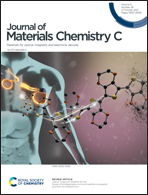Epitaxial growth of ZrSe2 nanosheets on sapphire via chemical vapor deposition for optoelectronic application†
Abstract
Group IVB (Zr and Hf) transition metal dichalcogenides (TMDs) have attracted considerable attention due to their predicted excellent electronic properties that are superior to group VIB TMDs. However, the synthesis of high-quality ZrSe2 layers is seldom reported, greatly hindering the development of this new field. Herein, the epitaxial growth of ZrSe2 on c-plane sapphire substrates is, for the first time, demonstrated using the low-pressure chemical vapor deposition (CVD) method. Impressively, the CVD-grown high-quality ZrSe2 layers exhibit an atomically sharp interface with the underlying substrate, and their epitaxial relationship is determined to be: ZrSe2 (0001)[10–10]||Al2O3 (0001)[11–20]. The electronic band structures of ZrSe2 are calculated using density functional theory methods, showing an indirect band gap of 1.19 eV and a minimum direct band gap of 1.79 eV, respectively. The band gap of ZrSe2 layers is also determined from the UV-visible absorption spectra, which is in good agreement with our band-structure calculations. Furthermore, a photodetector was fabricated based on the CVD-grown ZrSe2 layer on a sapphire substrate, which exhibits a stable and appreciable photoresponse for visible light.



 Please wait while we load your content...
Please wait while we load your content...